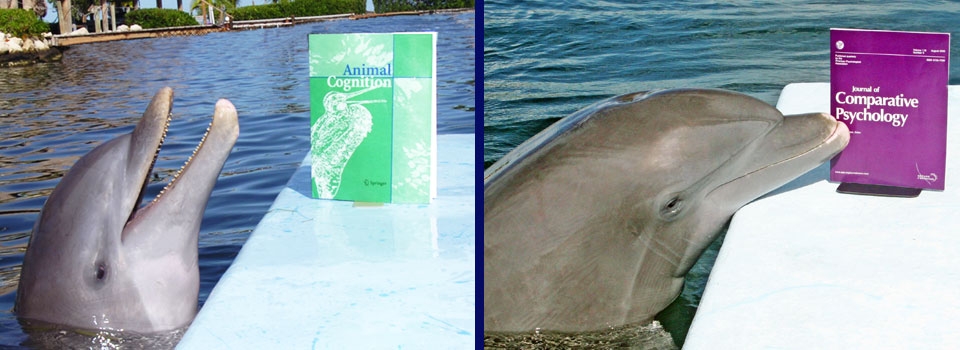References & Abstracts
Jaakkola, K. (2025). Do marmosets really have names? Learning & Behavior. https://doi.org/10.3758/s13420-024-00662-z
A recent study demonstrated that marmoset “phee calls” include information specific to the intended receiver of the call, and that receivers respond more to calls that are specifically directed at them. The authors interpret this as showing that these calls are name-like vocal labels for individual marmosets, but there is at least one other possibility that would equally explain these data.
Brignac, S., Haddock, A. Guarino, E., Jaakkola, K., & Rodriguez, M. (2024) Failure is an Option! Preventing Frustration in Research Training. Soundings, 49(2).
Dolphin Research Center (DRC) is able to study the minds of our resident dolphin family by teaching them “thinking games” and testing cognitive concepts that would be impossible to do in the wild. One of the challenges of training cognitive research is that often we are asking the dolphins a question that we do not know if they have the ability to answer. For trainers, this can be tough, as we always set the animals up to win, and learning through trial and error inevitably means that sometimes they will fail. But failure isn’t the end of the world: in fact, it is essential to learning. Here at DRC, we purposely put many positive aspects into our research training to make it fun and engaging, thus preventing frustration. In doing this we have effectively taught our dolphins that “Failure is an Option!”
Guarino, E., Haddock, A., McMullen, C., Brignac, S., Jaakkola, K., & Linaje, K. (2024). Dolphins In Facilities Are Instrumental In Developing Field Research Techniques. Soundings, 49(1).
Research with animals requires forethought and mindfulness to develop strong scientific studies and protect the well being of the animals being studied. In marine mammal facilities, dolphins can be willing partners through positive reinforcement training, so we can ask for their participation in refining research techniques. The same isn’t true for wild dolphins, with the result that they may be exposed to repeated stressors as researchers work out the kinks of data collection. The opportunity to conduct such important preliminary tasks with trained animals leads to stronger data from the field, with no stress on the cooperating resident dolphins and less stress on the wild dolphins.
Numerous studies have demonstrated the negative effects of impoverished environments versus the positive effects of enriched environments on animals’ cognitive and neural functioning. Recently, a hypothesis was raised suggesting that conditions for dolphins in zoological facilities may be inherently impoverished, and thus lead to neural and cognitive deficits. This review directly examines that hypothesis in light of the existing scientific literature relevant to dolphin welfare in zoological facilities. Specifically, it examines how dolphins are housed in modern zoological facilities, where the characteristics of such housing fall on the continuum of impoverished-to-enriched environments, and the extent to which dolphins show behavioral evidence characteristic of living in impoverished environments. The results of this analysis show that contrary to the original hypothesis, modern zoological facilities do not inherently, or even typically, house dolphins in impoverished conditions. However, it also notes that there is variation in animal welfare across different zoological facilities, and that “not impoverished” would be a particularly low bar to set as an animal welfare standard. To optimize cognitive well-being, strategies for providing additional cognitive challenges for dolphins in zoological facilities are suggested.
Jaakkola, K., Brignac, S., Erb, L., Guarino, E., Haddock, A., & Rodriguez, M. (2023). Trainer interaction can improve welfare outcomes of toy enrichment >for isolated animals: A case study. Journal of Zoological and Botanical Gardens, >4, 72-81. https://doi.org/10.3390/jzbg4010008
In cases where social animals must be temporarily housed alone, environmental enrichment is particularly important. Providing animals with manipulable objects (“toys”) is a common form of environmental enrichment, but its effectiveness can be limited by animal disinterest or habituation. The current study examined whether caregiver interaction could increase the effectiveness of object-based enrichment >for a quarantined bottlenose dolphin (Tursiops truncatus). Behavioral observations were conducted after a training session, after a trainer toy play session, and between interactive sessions. The results showed that the dolphin floated in place less and played with toys more after interacting with a caregiver than he did at times further removed from caregiver interaction. He was also more likely to play with the same toys that the trainer had played with, showing effects of stimulus enhancement and/or social referencing. Although this study is, of necessity, based on a single animal of a single species, these findings suggest that interacting with a caregiver can enhance the efficacy of object-based environmental enrichment >for isolated animals.
Sørensen, P. M., Haddock, A., Guarino, E., Jaakkola, K., McMullen, C., Jensen, F. H., Tyack, P. L., & King, S. L. (2023). Anthropogenic noise impairs cooperation in bottlenose dolphins. Current Biology. http://doi.org/10.1016/j.cub.2022.12.063
Understanding the impact of human disturbance on wildlife populations is of societal importance,with anthropogenic noise known to impact a range of taxa, including mammals, birds,fish,and invertebrates. While animals are known to use acoustic and other behavioral mechanisms to compensate for increasing noise at the individual level, our understanding of how noise impacts social animals working together remains limited. Here, we investigated the effect of noise on coordination between two bottlenose dolphins performing a cooperative task. We previously demonstrated that the dolphin dyad can use whistles to coordinate their behavior, working together with extreme precision. By equipping each dolphin with a sound-and-movement recording tag (DTAG-37) and exposing them to increasing levels of anthropogenic noise, we show that both dolphins nearly doubled their whistle durations and increased whistle amplitude in response to increasing noise. While these acoustic compensatory mechanisms are the same as those frequently used by wild cetaceans, they were insufficient to overcome the effect of noise on behavioral coordination. Indeed, cooperative task success decreased in the presence of noise, dropping from 85% during ambient noise control trials to 62.5% during the highest noise exposure. This is the first study to demonstrate in any non-human species that noise impairs communication between conspecifics performing a cooperative task. Cooperation facilitates vital functions across many taxa and our findings highlight the need to account for the impact of disturbance on functionally important group tasks in wild animal populations.
Rimbach, R., Amireh, A., Allen, A., Hare, B., Guarino, E., Kaufman, C., Salomons, H. and Pontzer, H. (2021). Total energy expenditure of bottlenose dolphins (Tursiops truncatus) of different ages. J. Exp. Biol. 224, jeb242218. https://doi.org/10.1242/jeb.242218
Marine mammals are thought to have an energetically expensive lifestyle because endothermy is costly in marine environments. However, measurements of total energy expenditure (TEE; kcal day−1) are available only for a limited number of marine mammals, because large body size and inaccessible habitats make TEE measurements expensive and difficult to obtain for many taxa. We measured TEE in 10 adult common bottlenose dolphins (Tursiops truncatus) living in natural seawater lagoons at two facilities (Dolphin Research Center and Dolphin Quest) using the doubly labeled water method. We assessed the relative effects of body mass, age and physical activity on TEE. We also examined whether TEE of bottlenose dolphins, and more generally of marine mammals, differs from that expected for their body mass compared with other eutherian mammals, using phylogenetic least squares (PGLS) regressions. There were no differences in body mass or TEE (unadjusted TEE and TEE adjusted for fat-free mass) between dolphins from the two facilities. Our results show that adjusted TEE decreased and fat mass increased with age. Different measures of activity were not related to age, body fat or adjusted TEE. Both PGLS and the non-phylogenetic linear regression indicate that marine mammals have an elevated TEE compared with that of terrestrial mammals. However, bottlenose dolphins expended 17.1% less energy than other marine mammals of similar body mass. The two oldest dolphins (>40 years) showed a lower TEE, similar to the decline in TEE seen in older humans. To our knowledge, this is the first study to show an age-related metabolic decline in a large non-human mammal.
King, S. L., Guarino, E., Donegan, K., McMullen, C., & Jaakkola, K. (2021). Evidence that bottlenose dolphins can communicate with vocal signals to solve a cooperative task. Royal Society Open Science, 8, 202073. Article text
Cooperation experiments have long been used to explore the cognition underlying animals’ coordination towards a shared goal. While the ability to understand the need for a partner in a cooperative task has been demonstrated in a number of species, there has been far less focus on cooperation experiments that address the role of communication. In humans, cooperative efforts can be enhanced by physical synchrony, and coordination problems can be solved using spoken language. Indeed, human children adapt to complex coordination problems by communicating with vocal signals. Here, we investigate whether bottlenose dolphins can use vocal signals to coordinate their behaviour in a cooperative button-pressing task. The two dolphin dyads used in this study were significantly more likely to cooperate successfully when they used whistles prior to pressing their buttons, with whistling leading to shorter button press intervals and more successful trials. Whistle timing was important as the dolphins were significantly more likely to succeed if they pushed their buttons together after the last whistle, rather than pushing independently of whistle production. Bottlenose dolphins are well known for cooperating extensively in the wild, and while it remains to be seen how wild dolphins use communication to coordinate cooperation, our results reveal that at least some dolphins are capable of using vocal signals to facilitate the successful execution of coordinated, cooperative actions.
Jaakkola, K., Loyer, C., Guarino, E., Donegan, K., & McMullen, C. (2021). Do dolphins really have a rightward lateralization for action? The importance of behavior-specific and orientation-neutral coding. Behavioural Brain Research, 401, 113083. Article text.
Because each side of the vertebrate body is controlled by a different side of the brain, studies of behavioral lateralization can provide insight into functional cerebral asymmetries in humans and other animals. The current study examined behavioral lateralization for a variety of behaviors in a group of 26 dolphins, in order to assess the claim that cetaceans show strong rightward action asymmetries indicative of a left-hemisphere specialization for action. We distinguished between side asymmetries and whole body turning actions, and devised a new coding system to counter the problem that previous studies of rolling behaviors (i.e., rotations around the long axis) have used contradictory coding systems depending on species' typical orientation. Our results did not support a generalized population-level rightward action asymmetry across multiple behaviors. Instead, we suggest that many dolphin behavioral asymmetries may be better explained as a result of perceptual processing asymmetries common across many vertebrates.
Jaakkola, K, Bruck, J.N., Connor, R.C., Montgomery, S.H., King, S.L. (2020). Bias and Misrepresentation of Science Undermines Productive Discourse on Animal Welfare Policy: A Case Study Animals, 10, 1118 Article text
Reliable scientific knowledge is crucial for informing legislative, regulatory, and policy decisions in a variety of areas. To that end, scientific reviews of topical issues can be invaluable tools for informing productive discourse and decision‐making, assuming these reviews represent the target body of scientific knowledge as completely, accurately, and objectively as possible. Unfortunately, not all reviews live up to this standard. As a case in point, Marino et al.’s [1] review regarding the welfare of killer whales in captivity contains methodological flaws and misrepresentations of the scientific literature, including problematic referencing, overinterpretation of the data, misleading word choice, and biased argumentation. These errors and misrepresentations undermine the authors’ conclusions and make it impossible to determine the true state of knowledge of the relevant issues. To achieve the goal of properly informing public discourse and policy on this and other issues, it is imperative that scientists and science communicators strive for higher standards of analysis, argumentation, and objectivity, in order to clearly communicate what is known, what is not known, what conclusions are supported by the data, and where we are lacking the data necessary to draw reliable conclusions.
Manitzas Hill HM, Jaakkola K. 2019. Public opinion of captive cetacean attractions: A critique of Wassermann et al. (2018) PeerJ Preprints 7:e27852v1 Article text
Wassermann et al. argued that previous public opinion research about marine mammal attractions should be considered unreliable due to possible biases in study design, which may have influenced participants’ responses. As in all scientific endeavors, reducing bias in order to gather more objective, evidence-based information is a worthy and commendable goal. Unfortunately, Wassermann et al. fell short in their efforts to produce an unbiased investigation into the beliefs of the general public about captive marine mammal attractions, due to a number of methodological flaws and biases in their own study. Specific concerns include a non-representative sample, methodological issues with data collection and coding procedures, a lack of reliability between data published and data provided, a failure to demonstrate inter-coder reliability, a failure to control for sequence effects in quantitative data, misrepresentation of databetween text and tables, and biased over-interpretation of qualitative responses. These errors undermine the authors’ conclusions and indeed render their findings uninterpretable. To achieve the goal of an unbiased understanding of public opinion about marine mammal attractions, further research on this topic is warranted using rigorous and sound scientific methodology.
Jaakkola, K., & Willis, K. (2019). How long do dolphins live? Survival rates and life expectancies for bottlenose dolphins in zoological facilities vs. wild populations. Marine Mammal Science, 35, 1418-1437. Article text
Survival rates and life expectancies are commonly agreed upon indicators of well-being for animals in zoological facilities, but even the most recent survival statistics for bottlenose dolphins (Tursiops truncatus) in marine mammal parks and aquariums use data that are now more than 25 yr old. The current study provides a comprehensive assessment of life expectancy and survival rates for bottlenose dolphins in U.S. zoological facilities from 1974 to 2012, utilizing three different analyses (annual survival rate, age-at-death, and Kaplan-Meier), examining historical trends, and comparing to comparable data from wild populations. Both survival rate and life expectancy for dolphins in zoological facilities increased significantly over the past few decades, with a modern ASR of 0.972, and mean and median life expectancies calculated via Kaplan-Meier of 28.2 and 29.2 yr, respectively. Survival rates and life expectancies for dolphins in U.S. zoological facilities today are at least as high as those for the wild dolphin populations for which there are comparable data.
Jaakkola, K., Guarino, E., Donegan, K., & King, S.L. (2018). Bottlenose dolphins can understand their partner’s role in a cooperative task. Proceedings of the Royal Society of London B: Biological Sciences, 20180948. Article text
In recent decades, a number of studies have examined whether various non-human animals understand their partner's role in cooperative situations. Yet the relatively tolerant timing requirements of these tasks make it theoretically possible for animals to succeed by using simple behavioural strategies rather than by jointly intended coordination. Here we investigated whether bottlenose dolphins could understand a cooperative partner's role by testing whether they could learn a button-pressing task requiring precise behavioural synchronization. Specifically, members of cooperative dyads were required to swim across a lagoon and each press their own underwater button simultaneously (within a 1 s time window), whether sent together or with a delay between partners of 1–20 s. We found that dolphins were able to work together with extreme precision even when they had to wait for their partner, and that their coordination improved over the course of the study, with the time between button presses in the latter trials averaging 370 ms. These findings show that bottlenose dolphins can learn to understand their partner's role in a cooperative situation, and suggest that the behavioural synchronization evident in wild dolphins' synchronous movement and coordinated alliance displays may be a generalized cognitive ability that can also be used to solve novel cooperative tasks.
Strobel, M.M., Houser, D.S., Moore, K.T., Davis, M.R., Clough, P.L., Staggs, L.A., Eskelinen, H.C., Bates, R.J., and Walsh, M.T. (2017). Auditory Evoked Potentials and Behavioral Considerations with Hearing Loss in Small Cetaceans: Application as a Standard Diagnostic Test in Health Assessment. Journal of Zoo and Wildlife Medicine 48(4): 979–986.
The primary sense in odontocetes is hearing and a large portion of the odontocete brain is devoted to the auditory processing of echolocation signals. Hearing deficits in odontocetes potentially compromise the ability to forage, navigate, socialize, and evade predators. This presents a challenge to survival and reproduction in wild odontocetes and can affect the general welfare of odontocetes under human care. Currently, little empirical information on how odontocete behavior is affected by hearing loss exists. This study investigated hearing deficits in several species of stranded dolphins and age-related hearing deficits in dolphins kept under human care through auditory evoked potential (AEP) testing and evaluated whether individual behavior correlated with hearing impairment. Behavioral questionnaires for participating animals were completed by individuals with extensive knowledge of the animals’ history and behavior. A chi-square analysis determined whether animals with hearing impairment demonstrated behaviors that differed significantly from those considered normal. All tested individuals under human care over 35 years of age had some degree of hearing loss, as did a large percentage of previously stranded animals. Individuals with hearing loss exhibited a range of behavioral changes, including delays in learning new behaviors, accepting novel enrichment, and habituating to new environments. Some individuals with profound hearing loss also displayed a change in vocalization rate in various situations. Findings within previously stranded animals suggest AEP studies should be conducted in all stranded individuals entering rehabilitation. It is further recommended that dolphins living under human care undergo hearing tests as part of their normal health assessments, with emphasis on aging individuals and animals that exhibit delayed learning, respond poorly to audible cues, or show atypical vocalization behavior.
King, S. L., Allen, S. J., Connor, R. C., & Jaakkola, K. Cooperation or dolphin 'tug-of-war'? Comment on Kuczaj et al. and Eskelinen et al. Animal Cognition, 19, 1227–1229.
Two recent papers by Kuczaj et al. (Anim Cognit 18:543–550, 2015) and Eskelinen et al. (Anim Cognit 19:789–797, 2016) claim to have demonstrated that (i) bottlenose dolphins (Tursiops truncatus) cooperated to solve a novel task and (ii) vocal signals were important for coordinating these cooperative efforts. Although it is likely that bottlenose dolphins may share communicative signals in order to achieve a common goal, we suggest that this has not been demonstrated in the aforementioned studies. Here, we discuss the two main problems that preclude any definitive conclusions being drawn on cooperative task success and vocal communication from these studies. The first lies in the experimental design. The ‘cooperative task’, involving an apparatus that requires two dolphins to pull in opposite directions in order to achieve a food reward, is not conducive to cooperation, but could instead reflect a competitive ‘tug-of-war’. It is therefore of questionable use in distinguishing competitive from cooperative interactions. Second, the suggestion that the occurrence of burst-pulsed signals in this task was indicative of cooperation is disputable, as (i) this study could not determine which dolphins were actually producing the signals and (ii) this sound type is more commonly associated with aggressive signalling in dolphins. We commend the authors for investigating this exciting and topical area in animal communication and cognition, but the question of whether dolphins cooperate and communicate to solve a cooperative task remains as yet unanswered.
King, S.L., Guarino, E., Keaton, L., Erb, L., & Jaakkola, K. (2016). Maternal signature whistle use aids mother-calf reunions in a bottlenose dolphin, Tursiops truncatus. Behavioural Processes, 126, 64-70.
Individual vocal signatures play an important role on parent-offspring recognition in many animals. One species that uses signature calls to accurately facilitate individual recognition is the bottlenose dolphin. Female dolphins and their calves will use their highly individualised signature whistles to identify and maintain contact with one another. Previous studies have shown high signature whistle rates of both mothers and calves during forced separations. In more natural settings, it appears that the calf vocalises more frequently to initiate reunions with its mother. However, little is known about the mechanisms a female dolphin may employ when there is strong motivation for her to reunite with her calf. In this study, we conducted a series of experimental trials in which we asked a female dolphin to retrieve either her wandering calf or series of inanimate objects (control). Our results show that she used her vocal signature to actively recruit her calf, and produced no such signal when asked to retrieve the objects. This is the first study to clearly manipulate a dolphin's motivation to retrieve her calf with experimental controls. The results highlight that signature whistles are not only used in broadcasting individual identity, but that maternal signature whistle use is important in facilitating mother-calf reunions.
King, S. L., Guarino, E., Donegan, K., Hecksher, J., & Jaakkola, K.(2016). Further insights into postpartum signature whistle use in bottlenose dolphins (Tursiops truncatus). Marine Mammal Science, 32: 1458–1469.
Individual vocal signatures help mothers recognize and provide care to their young in many animals. Mother-offspring recognition is particularly important when young animals are mobile immediately after birth, and separations can occur. Bottlenose dolphins are known to produce unique identity signals, signature whistles, to help individuals recognize one another. Here we show that new dolphin mothers will produce their signature whistle at much higher rates immediately after their calf is born, and continue to do so for up to a month. This increase helps the calf recognize its mother and allows mothers and calves to reunite if they become separated.
Robeck, T., Jaakkola, K., Stafford, G., & Willis, K. (2016). Killer whale (Orcinus orca) survivorship in captivity: A critique of Jett and Ventre (2015). Marine Mammal Science, 32, 786-792.
In the article "Captive killer whale (Orcinus orca) survival" (Jett and Ventre 2015), the authors attempt to provide a comprehensive analysis of historical survival rates of killer whales in marine mammal facilities, using factors such as sex, place of birth (wild vs. facility), and facility location (U.S. vs. non-U.S.). They frame this endeavor in terms of concern about the welfare of killer whales in marine parks, and attempt to make comparisons and draw conclusions about the welfare of such animals vs. those in wild populations. The welfare of any animal in a zoological setting is an important concern, and the issue of killer whales in particular has recently received a lot of media attention and, as a consequence, proposed specific legislation. We support and applaud the idea of bringing scientific data to bear on issues affecting the study, conservation, and public display of this and other species. However, and especially because such data will undoubtedly impact real-world decisions affecting this species, it is more imperative than ever that this work be rigorously carried out and presented in an equitable manner. The Jett and Ventre (2015) paper falls short of these standards in a number of ways.
Jaakkola, K. (2015). Making the strongest argument: Reply to Pepperberg (2015). Journal of Comparative Psychology, 129, 202-203.
Jaakkola (2014) argued that because the majority of studies of animals’ understanding of invisible displacement did not adequately control for the use of alternative lower-level strategies, clear and solid evidence for a conceptual understanding of invisible displacement existed only for great apes. Pepperberg (2015) takes issue with this conclusion with respect to Grey parrots. While I agree that olfactory and social cueing may not be issues of concern for parrots, I reiterate the need for a study that adequately controls for associative learning before we can confidently claim that parrots understand invisible displacement.
Jaakkola, K. (2014). Do animals understand invisible displacement? A critical review. Journal of Comparative Psychology, 128, 225-239.
The ability to mentally represent the movement of hidden objects (i.e., invisible displacement) is of theoretical importance due to its generally accepted status as an indicator of the development of a powerful type of representational capacity in human children. Over the past few decades, the understanding of invisible displacement has been claimed for a variety of animal species as well. However, a careful review of these studies finds that: (a) many were not properly blinded, (b) many did not properly control for lower-level associative strategies, and (c) success on simplified versions of the tasks can be explained by a simple attentional mechanism rather than by conceptual understanding. Indeed, when lower-level factors are controlled, evidence of understanding invisible displacement remains only for great apes.
Jaakkola, K., Guarino, E., Rodriguez, M., & Hecksher, J. (2013). Switching strategies: A dolphin's use of passive and active acoustics to imitate motor actions. Animal Cognition, 16, 701-709.
Scientists have long debated the extent to which animals can imitate. Observations of bottlenose dolphins suggest a sophisticated capacity for social imitation, but little is known about the nature of these abilities. Here, we explore the behavioral mechanisms underlying a dolphin’s ability to copy motor actions while blindfolded (i.e., wearing eyecups). When a dolphin was asked to imitate a dolphin, a human, and then another dolphin blindfolded, his accuracy remained relatively consistent across models. However, his blindfolded echolocation dramatically increased when copying a human as compared to other dolphins, suggesting he actively switched between strategies: recognizing behaviors via characteristic sounds when possible, but via echolocation for the more novel sounding behaviors of the human. Such flexibility in changing perceptual routes demonstrates that the dolphin’s imitation was not automatically elicited, but rather results from an intentional, problem-solving approach to imitation.
Jaakkola, K. (2012). Cetacean cognitive specializations. In J. Vonk & T. Shackleford (Eds.), The Oxford Handbook of Comparative Evolutionary Psychology (pp. 144–165). New York: Oxford University Press.
This chapter provides an in-depth discussion of the cognition of the most well known cetacean -- the bottlenose dolphin (Tursiops truncatus). First, observational and experimental evidence for various cognitive capacities is examined across four major areas: concepts and memory, physical cognition, social cognition, and symbolic cognition. The results suggest that dolphins possess a level of complex cognition largely on par with great apes, but surpass them in several areas of social cognition, and lag behind in one area of physical cognition. Next, evolutionary pressures hypothesized to account for the expansion of the dolphin neocortex and associated cognitive abilities are examined. It is suggested that, as with apes, the capacity for secondary representation may provide a key mechanism underlying dolphins' complex cognitive abilities.
Jaakkola, K., Guarino, E., & Rodriguez, M. (2010). Blindfolded imitation in a bottlenose dolphin (Tursiops truncatus). International Journal of Comparative Psychology, 23, 671–688.
This study investigated the ability of a bottlenose dolphin to adapt a previously learned "do-as-I-do" procedure to copy behaviors of another dolphin while blindfolded (i.e., wearing eyecups). In Experiment 1, the dolphin was able to copy both vocal and motor behaviors, whether blindfolded or sighted. Hydrophone recordings showed that he echolocated during many of the motor behaviors while blindfolded. In Experiment 2, blindfolded human trainers were able to identify the same model behaviors on the basis of their characteristic sounds. While it thus remains unclear whether the dolphin recognized the motor behaviors via echolocation or via their characteristic sounds, this is the first demonstration of such flexibility in using a new perceptual route to motor imitation in a nonhuman animal.
Muraco, H., Clough, P., Teets, V., Arn, D., & Muraco, M. (2010). Ovarian follicular dynamics during the luteinizing hormone surge in the bottlenose dolphin (Tursiops truncatus). International Journal of Comparative Psychology, 23, 723–733.
Characterizing the relationship between ovarian follicular dynamics and the luteinizing hormone (LH) surge in the bottlenose dolphin (Tursiops truncatus) requires detailed daily monitoring due to the transitory nature of LH and ovulation. Utilizing conditioned dolphins and non-invasive sampling techniques, such as urine collection and trans-abdominal ultrasound exams, provides the means to accurately monitor these fleeting processes. Urine samples and ultrasound exams used in this study were originally performed for the purposes of artificial insemination and controlled natural breeding. The LH surge was identified by a rapid immunochromatographic assay (ICG), and real-time B-mode trans-abdominal ultrasound imaging was used to identify pre-ovulatory follicles (POF). Increases in urinary progesterone levels along with the disappearance of the POF verified ovulation. This study found that POF diameters during the LH surge were 1.942 +/- 0.098 cm (n=9), and time to disappearance of the POF from the last recorded LH peak sample was 37.475 +/- 12.346 h (n = 6). Peak LH surge levels, based on samples collected 2 to 4 times daily, lasted 6.050 +/- 1.332 h (n = 6). Data suggests that bottlenose dolphins, like many other mammals, have brief ovulatory LH surges followed by ovulation within 48 hours.
Jaakkola, K., Guarino, E., Rodriguez, M., Erb, L., & Trone, M. (2010). What do dolphins (Tursiops truncatus) understand about hidden objects? Animal Cognition, 13, 103–120.
Object permanence, the ability to mentally represent and reason about objects that have disappeared from view, is a fundamental cognitive skill that has been extensively studied in human infants and terrestrial animals, but not in marine animals. A series of four experiments examined this ability in bottlenose dolphins (Tursiops truncatus). After being trained on a “find the object” game, dolphins were tested on visible and invisible displacement tasks, and transpositions. In Experiments 1 and 2, dolphins succeeded at visible displacements, but not at invisible displacements or transpositions. Experiment 3 showed that they were able to pass an invisible displacement task in which a person’s hand rather than a container was used as the displacement device. However, follow-up controls suggested they did so by learning local rules rather than via a true representation of the movement of hidden objects. Experiment 4 demonstrated that the dolphins did not rely on such local rules to pass visible displacement tasks. Thus, like many terrestrial animals, dolphins are able to succeed on visible displacement tasks, but seem unable to succeed on tasks requiring the tracking of hidden objects.
Sklansky, M., Renner. M., Clough, P., Levine, G., Campbell, M., Stone, R., Schmitt, T., Chang, R.K., & Shannon-Rodriguez, J. (2010). Fetal echocardiographic evaluation of the bottlenose dolphin (Tursiops truncatus). Journal of Zoo and Wildlife Medicine, 41, 35–43.
Fetal echocardiography represents the most important tool for the assessment of the cardiovascular well-being of the human fetus. Because of logistic, anatomic and behavioral challenges, detailed fetal echocardiographic evaluation of marine mammals has not been previously described. We sought to develop an approach to evaluating the fetal dolphin’s cardiovascular status using conventional, fetal echocardiographic techniques developed in humans. We evaluated eight singleton fetal bottlenose dolphins, each between 6 and 11 months gestation; 6 fetuses underwent two fetal echocardiographic evaluations each, 4 at 3 month intervals, and 2 at 0.5 month intervals. Evaluations were performed, without sedation, using a conventional, portable ultrasound system. Multiple transducers, probe positions, and maternal dolphin positions were utilized to maximize image quality. Fetal echocardiography included two-dimensional imaging and color flow mapping of the heart and great arteries, as well as pulsed Doppler evaluation of the umbilical artery and vein. A thorough evaluation of the fetal dolphins’ cardiovascular status was performed, with the greatest resolution between 8-9 months gestation. We demonstrated normal structure and function of the heart and great arteries, including the pulmonary veins, inferior vena cava, right and left atria, foramen ovale, tricuspid and mitral valves, right and left ventricles, ventricular septum, pulmonary and aortic valves, main pulmonary artery and ascending aorta. Pulsed Doppler techniques demonstrated normal umbilical arterial and venous waveforms, and color flow mapping demonstrated absence of significant valvar regurgitation. We conclude that fetal echocardiography, between 6-11 months gestation, can provide a safe and detailed assessment of the cardiovascular status of the fetal bottlenose dolphin.
Jaakkola, K., Fellner, W., Erb, L., Rodriguez, M., & Guarino, E. (2005). Understanding of the concept of numerically “less” by bottlenose dolphins (Tursiops truncatus). Journal of Comparative Psychology, 119, 296–303.
In two experiments, bottlenose dolphins (Tursiops truncatus) judged the ordinal relationship between novel numerosities. The dolphins were first trained to choose the exemplar with the fewer number of items when presented with just a few specific comparisons (e.g., 2 vs. 6, 1 vs. 3, and 3 vs. 7). Generalization of this rule was then tested by presenting the dolphins with all possible pairwise comparisons between 1 and 8. The dolphins chose the exemplar with the fewer number of items at levels far above chance, showing that they could recognize and represent numerosities on an ordinal scale. Their pattern of errors was consistent with the idea of an underlying analog magnitude representation.
Smith, J.D., Schull, J., Strote, J., McGee, K., Egnor, R., & Erb, L. (1995). The uncertain response in the bottlenose dolphin (Tursiops truncatus). Journal of Experimental Psychology, 124, 391–408.
Humans respond adaptively to uncertainty by escaping or seeking additional information. To foster a comparative study of uncertainty processes, we asked whether humans and a bottlenosed dolphin (Tursiops truncatus) would use similarly a psychophysical uncertain response. Human observers and the dolphin were given 2 primary discrimination responses and a way to escape chosen trials into easier ones. Humans escaped sparingly from the most difficult trials near threshold that left them demonstrably uncertain of the stimulus. The dolphin performed nearly identically. The behavior of both species is considered from the perspectives of signal detection theory and optimality theory, and its appropriate interpretation is discussed. Human and dolphin uncertain responses seem to be interesting cognitive analogs and may depend on cognitive or controlled decisional mechanisms. The capacity to monitor ongoing cognition, and use uncertainty appropriately, would be a valuable adaptation for animal minds. This recommends uncertainty processes as an important but neglected area for future comparative research.
Nathanson, D.E., & de Faria, S. (1993). Cognitive improvement of children in water with and without dolphins. Anthrozoös, 6, 17–29.
Orienting nonverbal responses and verbal reponses of eight children with mental disabilities interacting in water with dolphins and in water with favorite toys away from dolphins were recorded and analyzed on videotape. Significant improvements in hierarchial cognition responses occurred when interaction with dolphins was used as a favorite toy. Water work with dolphins evoked a greater number of and higher level responses than without dolphins.
Nathanson, D.E. (1989). Using Atlantic bottlenose dolphins to increase cognition of mentally retarded children. In P. H. Lovibond & P. H. Wilson (Eds.), Clinical and Abnormal Psychology (pp. 233–242). Amsterdam: Elsevier Science Publishers.
Atlantic bottlenose dolphins were used to help I ncrease cognition for mentally retarded children. Six mentally retarded boys were taught new vocabulary words through interaction with dolphins. Novelty, prior learning, order and position effects were all controlled. A multiple baseline across subjects single subject research design was used to assess the effect of interaction with dolphins on speech and memory. Line drawings were presented on boards in treatment in the water by humans and dolphins and in baseline in a classroom away from the dolphins. All research was videotaped. Results indicated children learned two to ten times faster and with greater retention when working with dolphins. Benefits include new evidence of the efficacy of using nonhuman species to help humans improve cognition.
Geraci, J.R., St. Aubin, D.J., & Reisman, R.J. (1983). Bottlenose dolphins, Tursiops truncatus, can detect oil. Canadian Journal of Fisheries and Aquatic Sciences, 40, 1516–1522.
Two trained bottlenose dolphins, Tursiops truncatus, were tested for their ability to detect visually 12 different oils and 22 oil mixtures confined at the surface in small cylinders. Detection thresholds were established in tests using progressively lighter substances. The animals detected 6-mm slicks of crude, residual, and refined motor oils, and diesel slicks thicker than 17 mm. They could not detect 6-mm thicknesses of leaded gasoline or transparent mineral oil. One dolphin's ability to detect oil improved with experience. While blindfolded, one dolphin could detect 12-mm-thick samples of two crude oils, Bunker C and mineral oil, but only when the latter two were churned and contained air bubbles. We conclude that dolphins detect the thicker concentrations of oil that occur near the source of an oceanic spill, but not lightly colored or refined products that tend to disperse into thin films.











